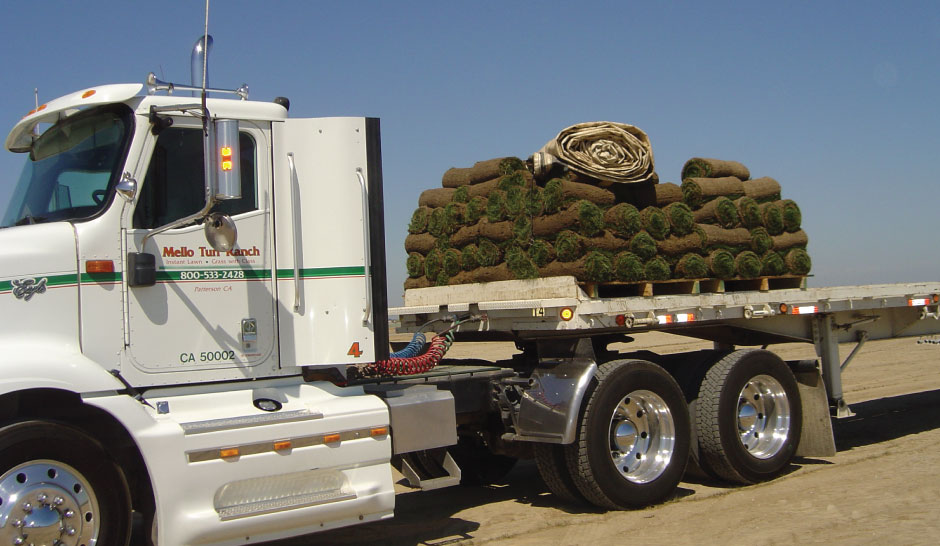Sod
PLANTING & MAINTENANCE
Soil Preparation Similar to Sowing Procedures
Sod should be planted on a well-prepared soil in the same way as if you were drilling the grass. The soil preparation should result in a soil which is fit for cultivation: smooth, free of weeds, grass, rocks and other debris. It might be necessary to grub the area as if the soil structure is too compact. Plow, rotate, or dig depending on the size of the area. Then cultivate the area with a harrow or a rake to level it. The soil shouldn't be too loose.
Packing the soil is very important. Any irregularities in the soil will show after the sod has been planted. When connecting the sod to paths etc., remember to take the thickness of the sod (approx. 1 inch) into consideration.

Irrigation Before Planting
The soil must be irrigated thoroughly about 24 hours before planting the sod. It is difficult to irrigate the underlying soil after planting the sod. If it's not irrigated well, the growing layer will absorb all moisture from the sod.
Storing Sod in Shade and Under Shelter
The sod is a perishable product. It rot quickly when stored in hot temperatures. For this reason you should plant the sod immediately after you have received it. The pallets of sod to be used last should be stored in shade and under shelter to minimize drying and heating. If the sod roles look dry, you should give them a light shower.
Planting the Sod in Forband
Your work will be easier if you start planting the roles from the longest straight borderline, and then work your way out from there. If you plant the grass sods in "forband", the connections will not show significantly. The end cuttings can easily be formed with a spade or knife. A driveway could be established by placing plates over the planted grass. Avoid traffic with heavy equipment on the grass right after planting.
Contact Between Soil and Grass Roots
The turf will easily establish its roots into the soil as long as there is a good contact between the sod and the soil. Gentle rolling the sod may be beneficial. Large heavy rollers must be avoided as they do more harm than good. You should roll the lawn immediately after planting, and before irrigating the lawn for the first time.
Let the Grass Rest
Keep traffic away from the lawn for two to three weeks. The grass needs time to establish.
Irrigation is a Must
Generously irrigating is necessary to obtain a good result. You must water immediately after you have planted the grass and rolled it. The grass and the soil underneath it must be kept moist continuously until the grass has established.
The amount of water to be used depends on the weather conditions. Be aware that in hot and windy weather the the grass will dry rapidly. We recommend irrigating with 6-8 inches (15 – 20 mm) water every second or third day in the beginning, then gradually expand the span between the days concurrently with the establishment of the grass roots. Bear in mind that the soil must be kept continuously moist until the grass has established.
Connections Filled with Top Dressing
Having planted the sod, minor gaps etc. in the connections can be filled with a top dressing of fine sand, preferably with more than 70% coarse sand or topsoil mixed with sand similar to the topsoil of the area. Using a drag net to level and get the sand into the connections is recommended. This topdressing should be applied with light equipment immediately after planting.
Mowing Height
You should mow the grass as usual. A cutting height of 1.25 to 1.5 inches (3 to 4 cm) is preferable. You should never cut more than 1/3 of the total grass height in one mowing.
Fertilizing
Three weeks after having planted the sod, it is recommended that you fertilize the lawn with 2-3 lbs (2 to 3 kg) of NPK-fertilizer (16-4-12)* per 100 sq. ft. or a similar fertilizer product. This fertilization should be repeated after 6 to 8 weeks.
* 16% Nitrogen, 4% Phosphate, 12% Potassium
Postpone vertical cutting
You should wait about 2 months before you give the lawn a vertical cutting as the grass must be well established first. The vertical cutting is done as usual when the grass is in good growth in April/May or August/September.
Guidelines to Avoid Problems:
-
The Turf Does Not Establish its Roots
In 10 days the turf will establish new white roots. If not, you must check to see if the lawn needs to be irrigated. Turf laying in the shade will establish roots very slowly or not at all. For this reason, we do not recommend planting turf in areas exposed to total shade. -
Brown or Grey-Blue Spots
Fungus diseases can attack turf, however, in most cases, the spots on recently planted turf are caused by lack of moisture. -
Mushrooms
A number of mushrooms will create fruit bodies (toadstools) in late summer when temperature and humidity conditions are suitable. If you find other mushrooms in the lawn, they should be identified in order to decide their toxicity.
